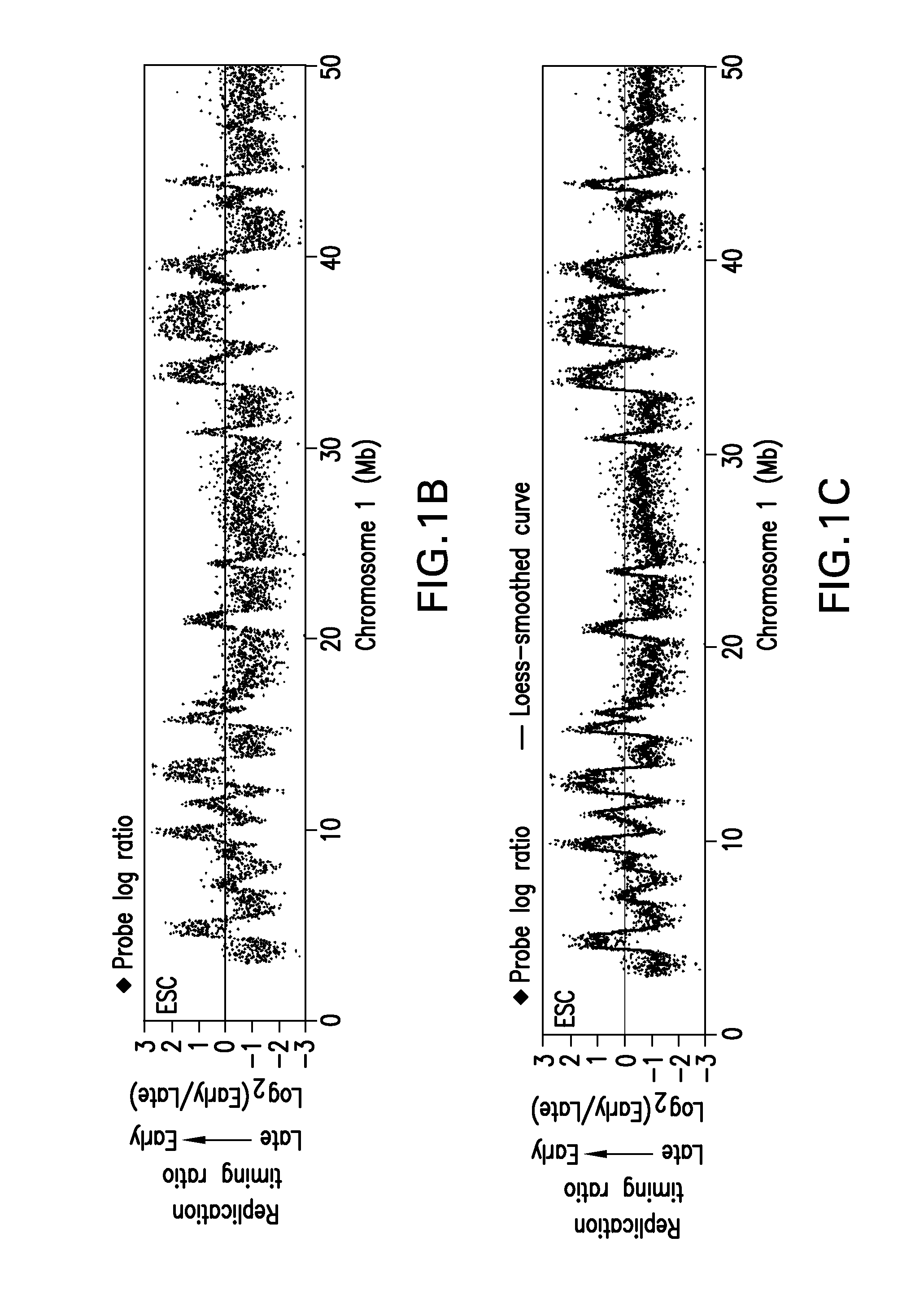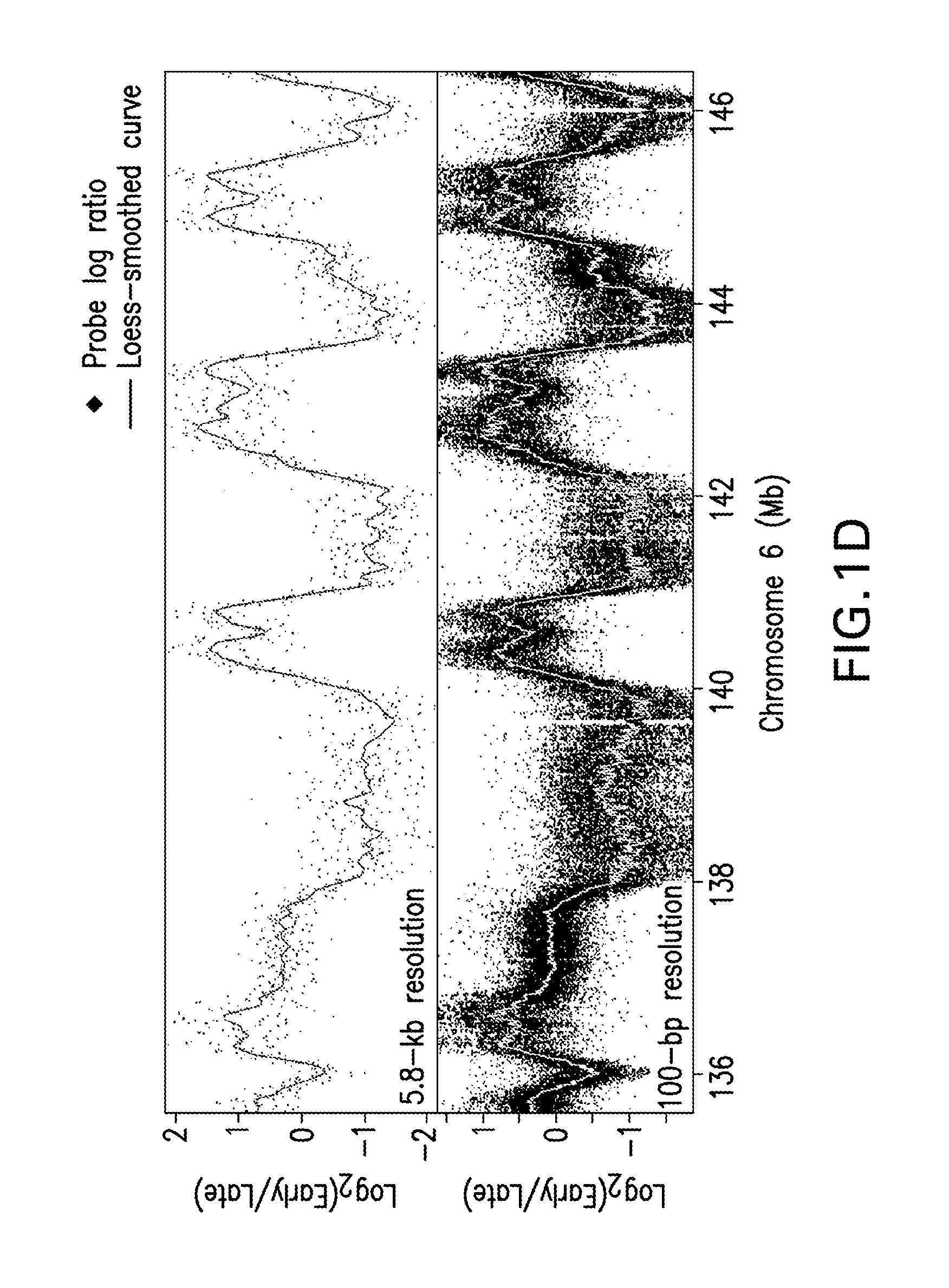Genome-scale analysis of replication timing
a gene-scale analysis and replication timing technology, applied in the field of gene-scale analysis of replication timing, can solve the problems of insufficient information to distinguish various types of cells, difficult to distinguish most cells based on appearance alone, and inability to apply in a high-throughput manner
- Summary
- Abstract
- Description
- Claims
- Application Information
AI Technical Summary
Benefits of technology
Problems solved by technology
Method used
Image
Examples
example 1
Materials and Methods
ESC Culture, Neural Differentiation and BrdU-Labeling
[0198]D3 cells (see, e.g., Doetschman et al., “The in vitro development of blastocyst-derived embryonic stem cell lines: formation of visceral yolk sac, blood islands and myocardium,”J. Embryol. Exp. Morphol. 87:27-45 (1985), the entire contents and disclosure of which are incorporated herein by reference), 46C cells (see, e.g., Ying et al., “Conversion of embryonic stem cells into neuroectodermal precursors in adherent monoculture,”Nat. Biotechnol. 21:183-86 (2003), the entire contents and disclosure of which are incorporated herein by reference), and TT2 cells (see, e.g., Yagi et al., “A novel ES cell line, TT2, with high germline-differentiating potency,”Anal. Biochem. 214:70-76 (1993), the entire contents and disclosure of which are incorporated herein by reference) are male ESC lines with a normal karyotype that are cultured in the presence of LIF (leukemia inhibitory factor) as described in, for example,...
example 2
Replication Domain Structure in Embryonic Stem Cells
[0209]Replication timing is mapped in mESCs using high-density oligonucleotide arrays, adapting a previously developed retroactive synchronization method. See, e.g., Schubeler et al., “Genome-wide DNA replication profile for Drosophila melanogaster: a link between transcription and replication timing,”Nat. Genet. 32:438-42 (2002); and Gilbert DM, “Temporal order of replication of Xenopus laevis 5S ribosomal RNA genes in somatic cells,”PNAS USA 83:2924-28 (1986), the entire contents and disclosures of which are incorporated herein by reference. ESCs are chosen because they provide the opportunity to directly evaluate dynamic changes in the replication program in response to changes in growth conditions (see, e.g., Hiratani et al., “Differentiation-induced replication-timing changes are restricted to AT-rich / long interspersed nuclear element (LINE)-rich isochores,”PNAS USA 101:16861-66 (2004); and Perry et al., “A dynamic switch in t...
example 3
Domain Structure is Conserved Between Independent mESC Lines
[0213]The results described above demonstrate that coordinately replicated regions (replication domains) constitute functional units of chromosomes whose boundaries may be molecularly defined. The fact that replication domain boundaries may be so precisely mapped in populations of cells demonstrates that their positions are highly stable from cell cycle to cell cycle. To evaluate whether these boundaries are a conserved property of chromosomes in multiple mESCs, three mESC lines from two independently established mouse inbred strains are compared. Lines D3 and 46C are both derived from the 129 mouse strain and so are nearly identical genetically, but they are separated by more than 20 years in cell culture, while TT2 was derived 15 years ago from a C57BL / 6xCBA hybrid mouse and is therefore genetically polymorphic (see, e.g., Doetschman et al. (1985), supra; Yagi, et al. (1993), supra; and Ying et al. (2003), supra). Despite...
PUM
| Property | Measurement | Unit |
|---|---|---|
| Fraction | aaaaa | aaaaa |
| Fraction | aaaaa | aaaaa |
| Length | aaaaa | aaaaa |
Abstract
Description
Claims
Application Information
 Login to View More
Login to View More - R&D
- Intellectual Property
- Life Sciences
- Materials
- Tech Scout
- Unparalleled Data Quality
- Higher Quality Content
- 60% Fewer Hallucinations
Browse by: Latest US Patents, China's latest patents, Technical Efficacy Thesaurus, Application Domain, Technology Topic, Popular Technical Reports.
© 2025 PatSnap. All rights reserved.Legal|Privacy policy|Modern Slavery Act Transparency Statement|Sitemap|About US| Contact US: help@patsnap.com



